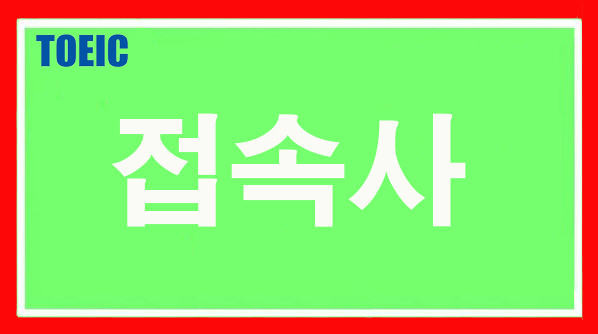
안녕하세요.
여러분의 토익친구 '구구맨'입니다.
토익 기초부터 함께하는 분들을 위해
토익기초문법 중 "부정사"를 준비했습니다.
오늘 하루 딱 30분만 투자하세요!
[접속사]
* 접속사 vs 전치사
| 접속사 | 전치사 | |
| 이유 | because | because of, due to, owing to, on account of |
| 시간 | while | during |
| 양보 | although, though, even if, even though | despite, in spite of |
| 양태 | as | like |
| 비례 | according as | according to |
| 제외 | but that, except that, save that | but for, except for, except |
| 경우 | in case | in case of |
| 완료 | by the time | by |
* 전치사와 접속사로 쓰이는 단어
· 전치사로 쓰일 때와 접속사로 쓰일 때 의미가 같은 단어 : before / after / until / like / plus / than / considering, assuming
· 의미가 달라지는 단어
| 접속사 | 전치사 | |
| as | - 때문에, -할 때(동시에), -대로 | -로서 (자격, 신분) |
| for | -때문에 | -을 위하여, -에 대하여, -을 향해 |
| since | -이래로, -때문에 | -이래로 |
3. 접속부사
- 접속부사는 연결하는 부사이지 접속사가 아니다.
| therefore | 따라서 | otherwise | 그렇지 않으면, 그 외에는 |
| thus | in fact | 사실 | |
| nevertheless | 그럼에도 불구하고 | on the contrary | 반대로 |
| nonetheless | in short | 요컨대 | |
| meanwhile | 반면에, 동시에 | afterward(s) | 후에, 나중에 |
| also | 또한 | if so | 만약 그렇다면 |
| then | 그 다음에 | likewise | 이와 같이 |
| rather | 꽤, 약간, 상당히 | until now | 지금까지 |
| instead | 대신에 | since then | -이래로 |
| in other words | 다르게 말하면 | as a result | 그 결과 |
| besides | 게다가 | for instance | 예를 들어 |
| in addition |
- 접속부사는 부사이므로 한 문장 안에서 두 개의 문장을 연결할 수 없다. 따라서 문장을 연결할 때는 and나 ; 뒤에 온다.
ex) At the end of this group meeting, we took a guided tour of history museum and then, had lunch together.

4. 부사절 축약
- “부사절 접속사 + 문장”은 축약할 수 있는데, 부사절 접속사는 그대로 두고, 주어는 생략하되, 동사가 능동태면 Ving를 /
수동태면 p.p를 쓴다.
ex) When sales representatives deal with difficult customers, they are instructed to treat them as politely as possible.
= When dealing with difficult customers, they are instructed to treat them as politely as possible.
· 부사절의 주어와 주절의 주어가 다른 경우에도 문맥상 주어를 유추할 수 있다면 접속사 뒤의 주어는 생략 가능하다.
ex) When you apply for a loan, falsifying income information can have serious consequence.
= When applying for a loan, falsifying income information can have serious consequence.
- 부사절 접속사에 따라 축약 형태가 다르다.
· When + Ving / p.p (-때), While + Ving / p.p (-동안에)
ex) When you make a speech, ~ = When making a speech, ~
ex) When I was trained by Mr. Kim, ~ = When trained by Mr. Kim, ~
ex) While you stay at this hotel, ~ = While staying at this hotel, ~
| 18. 접속사 |
· Before / After / Since + Ving / being p.p
· As / Though / If / Once / Unless / Than(-보다) + p.p
ex) The event proceed as it was planned. = The event proceed as planned.
ex) The profits were higher than they were predicted. = The profits were higher than predicted.
· 축약이 불가능한 접속사 : because / so that / in case
- 부사절 접속사 + Ving vs 전치사 + Ving
· 접속사 + Ving : When Ving / While Ving / Before Ving / After Ving / Since Ving(-한 이래로)
· 전치사 + Ving : without Ving / besides(=in addition to) Ving / instead of Ving / except Ving / by Ving / in Ving
/ on(upon) Ving / for Ving
* during은 전치사지만 뒤에 동명사가 올 수 없다.
5. 명사절 접속사
① 명사절
- 문장/절 앞에 명사절 접속사를 붙이면 ‘명사’ 역할을 하는 명사절이 된다.
=> 주어 역할, 목적어 역할, 보어 역할.
② 명사절 접속사의 종류와 역할
- that(-라는 점) / if, whether(-인지 아닌지) / when / where / how / why / whose 뒤에는 완전한 문장이 온다.
· 접속사 that : 동격의 명사절은 “추상명사 + that + 완전한 문장” 의 어순.
| fact | 사실 | truth | 진실 |
| statement | 언급 | opinion | 의견 |
| news | 뉴스 | rumor | 유언비어 |
| report | 보고서 | right | 권리 |
ex) The news that his son was found was not true.
· 접속사 if와 whether : ‘~인지 아닌지’
-> whether의 용법 : 주어 목적어, 보어의 역할.
-> if절을 쓰면 안 되는 경우 : 바로 뒤에 or not이 동반된 경우 / 주어로 사용하지 않는다. (문두에 오지 않는다) / 바로 뒤에 to부정사가 오지 않는다 /
전치사의 목적어로는 사용하지 못한다.
ex) I don’t know whether she will come (or not). (O)
ex) I don’t know if or not she will come. (X)
ex) Whether it is a good plan or not is a matter for argument. (O)
ex) If it is a good plan or not is a matter for argument. (X)
ex) I don’t know if going there alone is dangerous. (O)
ex) I don’t know if to go there alone is dangerous. (X)
ex) You must think about whether you want to continue a close friendship with your friends. (O)
ex) You must think about if you want to continue a close friendship with your friends. (X)
- who / whom 뒤에는 불완전한 문장이 온다.
· who(누구) : 주어 X. ex) Who will be offered the position has not yet been decided.
· whom(누구를) : 목적어 X. ex) Everyone wants to know whom Mr. Baker will take with him for the party.
- what은 대체로 불완전한 문장이, which는 대체로 완전한 문장이 오지만 의미에 따라 완전/불완전문장이 올 수도 있다.
· what – 뒤에 주어나 목적어가 없으며, “무엇, 어떤 것”이라는 뜻으로 쓰인다. + 불완전문장
ex) The annual report describes what the company needs to change.
· what – 뒤의 명사를 수식하며, “무슨”이라는 뜻으로 쓰인다. + 완전문장
ex) Mr. Green should keep track of what products customers buy.
· which – 뒤의 명사를 수식하며, “어느”라는 뜻으로 쓰인다. + 완전문장
ex) This document shows which company you want to work for.
· which – 뒤에 주어나 목적어가 없으면, “어느 것, 어떤 사람”이라는 뜻으로 쓰인다. + 불완전문장
ex) Pease tell Mr. Allen which book you have chosen.
| 18. 접속사 |
③ 주의해야 할 명사절 접속사
- whether
· whether + 완전문장. ex) Ms. Turner asked whether(or not) it is possible to take a month vocation.
· whether + to V. ex) The company is considering whether(or not) to close down the manufacturing facility.
· whether + A or B . ex) Please notify the personnel department whether you want to say home or you want to move another city.
| * whether 뒤에 or nor은 whether 바로 뒤나 문장 끝에 쓰인다. * whether만 있을 때는 명사절 접속사이고, whether가 or not과 함께 쓰이거나 whether A or B의 형태일 때는 명사절/부사절 접속사로 쓰인다. |
- if / that
· if 명사절 : 주어의 역할을 할 수 없다.
ex) If(-> Whether) the company will implement the new advertising campaign will be discussed during the meeting.
· if / that 명사절 : 전치사 뒤에 올 수 없다.
ex) Customers have concerns about if(-> whether) the department store will close for a month for renovation.
ex) Here are some suggestions about that(-> what) you should wear when working outside the factory.
- 명사절 접속사 + to V
· what / who / whom / when / where / how / whether 뒤에는 문장뿐만 아니라 to V 형태도 올 수 있으며, 이 복합체는 명사 역할
을 한다. ex) This manual describes specifically how to build the furniture.
· why / that 뒤에는 to V가 올 수 없고, which / whose + 명사 + to V의 형태로 쓰인다.
· what / whom + to V가 쓰일 때는 to V의 목적어는 없어야 하지만, 그 외의 의문사(who, when, where, how, whether)가 쓰일 때는 to V의
뒤에 문장 구성 요소가 빠져서는 안 된다.
ex) The new cook book helped to figure out what to serve to guests attending the party.
ex) Ms. Davis wants to know where to meet the representatives from each department.

오늘도 수고하셨습니다.

'토익 기초문법' 카테고리의 다른 글
| 오늘은 이것만 공부하세요. 토익 기초 문법[관계사-2] (0) | 2022.06.20 |
|---|---|
| 오늘은 이것만 공부하세요. 토익 기초 문법[관계사-1] (0) | 2022.06.19 |
| 오늘은 이것만 공부하세요. 토익 기초 문법[접속사-1] (0) | 2022.06.17 |
| 오늘은 이것만 공부하세요. 토익 기초 문법[분사] (0) | 2022.06.16 |
| 오늘은 이것만 공부하세요. 토익 기초 문법[동명사] (0) | 2022.06.15 |



